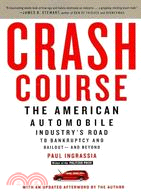This is the epic saga of the American automobile industry's rise and demise, a compelling story of hubris, denial, missed opportunities, and self-inflicted wounds that culminates with the president of the United States ushering two of Detroit's Big Three car companies—once proud symbols of prosperity—through bankruptcy. The cost to American taxpayers topped $100 billion—enough to buy every car and truck sold in America in the first half of 2009. With unprecedented access, Pulitzer Prize winner Paul Ingrassia takes us from factory floors to small-town dealerships to Detroit's boardrooms to the inner sanctums of the White House. He reveals why President Barack Obama personally decided to save Chrysler when many of his advisors opposed the idea. Ingrassia provides the dramatic story behind Obama's dismissal of General Motors CEO Rick Wagoner and the angry reaction from GM's board—the same people who had watched idly while the company plunged into penury.
In Crash Course, Ingrassia answers the big questions: Was Detroit's self-destruction inevitable? What were the key turning points? Why did Japanese automakers manage American workers better than the American companies themselves did? He also describes dysfunctional corporate cultures (even as GM's market share plunged, the company continued business as usual) and Detroit's perverse system of "inverse layoffs" (which allowed union members to invoke seniority to avoid work). Along the way we meet Detroit's frustrated reformers and witness the wrenching decisions that Ford executives had to make to avoid GM's fate.
Informed by Ingrassia's twenty-five years of experience covering the auto industry for The Wall Street Journal, and showing an appreciation for Detroit's profound influence on our country's society and culture, Crash Course is a uniquely American and deeply instructive story, one not to be missed.
From the Hardcover edition.












